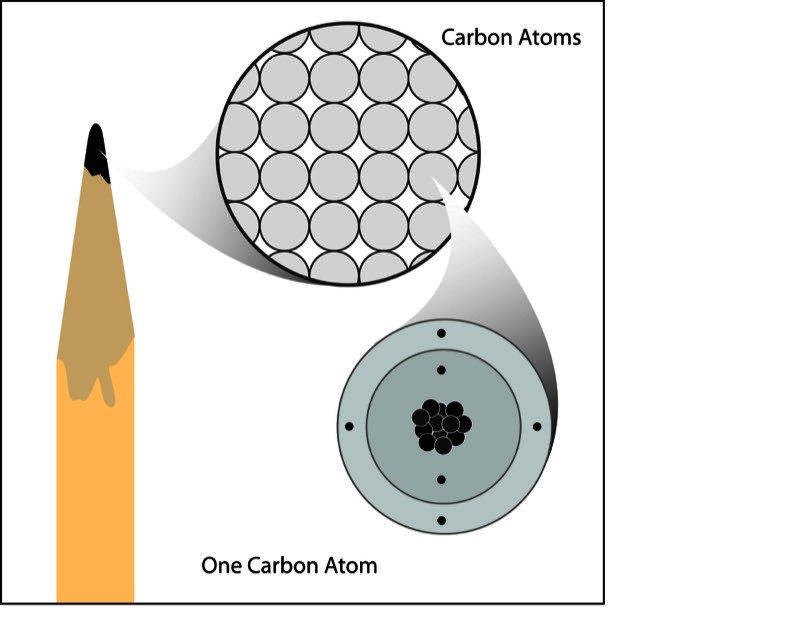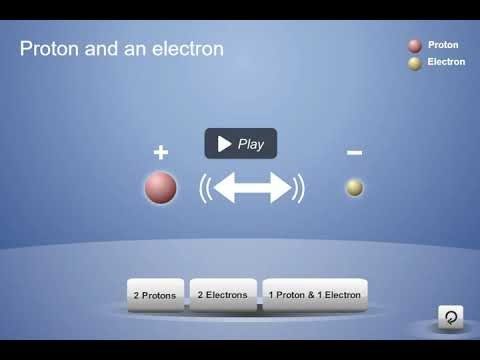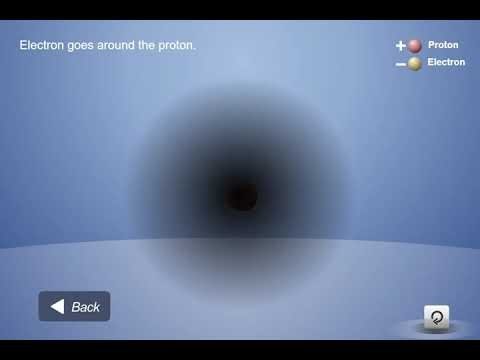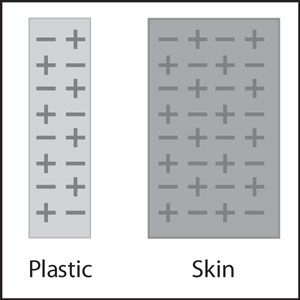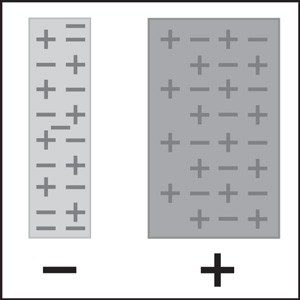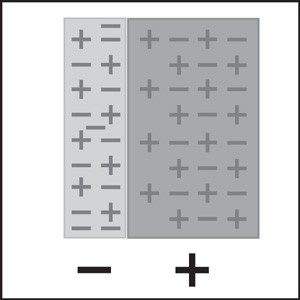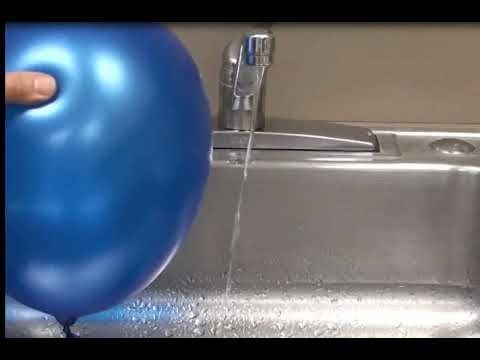Protons, Neutrons, and Electrons
Lesson Summary Video for teachers
Note: This video is designed to help the teacher better understand the lesson and is NOT intended to be shown to students. It includes observations and conclusions that students are meant to make on their own.
Key Concepts
- Atoms are made of extremely tiny particles called protons, neutrons, and electrons.
- Protons and neutrons are in the center of the atom, making up the nucleus.
- Electrons surround the nucleus.
- Protons have a positive charge.
- Electrons have a negative charge.
- The charge on the proton and electron are exactly the same size but opposite.
- Neutrons have no charge.
- Since opposite charges attract, protons and electrons attract each other.
Summary
Students will put a static charge on a strip of plastic by pulling it between their fingers. They will see that the plastic is attracted to their fingers. Students will be introduced to the idea that rubbing the strip with their fingers caused electrons to move from their skin to the plastic giving the plastic a negative charge and their skin a positive charge. Through these activities, students will be introduced to some of the characteristics of electrons, protons, and neutrons, which make up atoms.
Objective
Students will be able to explain, in terms of electrons and protons, why a charged object is attracted or repelled by another charged object. They will also be able to explain why a charged object can even be attracted to an uncharged object. Students will also be able to explain that the attraction between positive protons and negative electrons holds an atom together.

Safety
Be sure you and the students wear properly fitting goggles.
Materials for Each Group
- Plastic grocery bag
- Scissors
- Inflated balloon
- Small pieces of paper, confetti-size
Materials for the Demonstration
- Sink
- Balloon
Download All Lesson 4.1 Resources
Get the entire lesson plan and Student Activity Sheet for "Lesson 4.1 - Protons, Neutrons, and Electrons."
Online Assignments
Supplement in-class learning with interactive, multimedia-rich Google Forms lesson modules, perfect for reinforcing key chemistry concepts and scientific investigation skills.
Instructions
1 Engage
Step 1
Show a picture of a pencil point and how the carbon atoms look at the molecular level.
Project the image Pencil Zoom.
Students should be familiar with the parts of the atom from Chapter 3 but reviewing the main points is probably a good idea.
Ask students questions such as the following:
- What are the three different tiny particles that make up an atom?
Protons, neutrons, and electrons. - Which of these is in the center of the atom?
Protons and neutrons are in the center (nucleus) of the atom. You may want to mention that hydrogen is the only atom that usually has no neutrons. The nucleus of most hydrogen atoms is composed of just 1 proton. A small percentage of hydrogen atoms have 1 or even 2 neutrons. Atoms of the same element with different numbers of neutrons are called isotopes. These will be discussed in Lesson 2. - What zooms around the nucleus of an atom?
Electrons - Which one has a positive charge, a negative charge, and no charge? Proton—positive; electron—negative; neutron—no charge. The charge on the proton and electron are exactly the same size but opposite. The same number of protons and electrons exactly cancel one another in a neutral atom.
Note: The picture shows a simple model of the carbon atom. It illustrates some basic information like the number of protons and neutrons in the nucleus. It also shows that the number of electrons is the same as the number of protons. This model also shows that some electrons can be close to the nucleus and others are further away. One problem with this model is that it suggests that electrons orbit around the nucleus in perfect circles on the same plane, but this is not true.
The more widely accepted model shows the electrons as a more 3-dimensional “electron cloud” surrounding the nucleus. Students will be introduced to these ideas in a bit more detail in Lesson 3. But for most of our study of chemistry at the middle school level, the model shown in the illustration will be very useful. Also, for most of our uses of this atom model, the nucleus will be shown as a dot in the center of the atom.
Step 2
Show animations and explain that protons and electrons have opposite charges and attract each other.
Project the animation Protons and Electrons.
Explain to students that two protons repel each other and that two electrons repel each other. But a proton and an electron attract each other. Another way of saying this is that the same or “like” charges repel one another and opposite charges attract one another.
Since opposite charges attract each other, the negatively charged electrons are attracted to the positively charged protons. Tell students that this attraction is what holds the atom together.
Project the animation Hydrogen Atom.
Explain to students that in a hydrogen atom, the negatively charged electron is attracted to the positively charged proton. This attraction is what holds the atom together.
Tell students that hydrogen is the simplest atom. It has only 1 proton, 1 electron, and 0 neutrons. It is the only atom that does not have any neutrons. Explain that this is a simple model that shows an electron going around the nucleus.
Click on the button “Show cloud” and explain to students that this is a different model. It shows the electron in the space surrounding the nucleus that is called an electron cloud or energy level. It is not possible to know the location of an electron but only the region where it is most likely to be. The electron cloud or energy level shows the region sur- rounding the nucleus where the electron is most likely to be.
Note: Inquisitive students might ask how the positively charged protons are able to stay so close together in the nucleus: Why don’t they repel each other? This is a great question. The answer is well beyond an introduction to chemistry for middle school, but one thing you can say is that there is a force called the “Strong Force,” which holds protons and neutrons together in the nucleus of the atom. This force is much stronger than the force of repulsion of one proton from another.
Another good question: Why doesn’t the electron smash into the proton? If they are attracted to each other, why don’t they just collide? Again, a detailed answer to this question is beyond the scope of middle school chemistry. But a simplified answer has to do with the energy or speed of the electron. As the electron gets closer to the nucleus, its energy and speed increases. It ends up moving in a region surrounding the nucleus at a speed that is great enough to balance the attraction that is pulling it in, so the electron does not crash into the nucleus.
2 Evaluate
Give each student an activity sheet.
- Lesson 4.1 Student Activity Sheet PDF | DOCX | Google Doc
- Lesson 4.1 Activity Sheet Answers PDF | DOCX | Google Doc
Download the student activity sheet, and distribute one per student.
The activity sheet will serve as the “Evaluate” component of each 5-E lesson plan. The activity sheets are formative assessments of student progress and understanding. A more formal summative assessment is included at the end of each chapter.
Students will record their observations and answer questions about the activity on the activity sheet. The Explain It with Atoms and Molecules and Take It Further sections of the activity sheet will either be completed as a class, in groups, or individually depending on your instructions. Look at the teacher version of the activity sheet to find the questions and answers.
3 Explore
Step 3
Do an activity to show that electrons and protons attract each other.
Students can see evidence of the charges of protons and electrons by doing an activity with static electricity.
Note: When two materials are rubbed together in a static electricity activity, one material tends to lose electrons while the other material tends to gain electron. In this activity, human skin tends to lose electrons while the plastic bag, made of polyethylene, tends to gain electrons.
Question to investigate
What makes objects attract or repel each other?
Materials for each group
- Plastic grocery bag
- Scissors
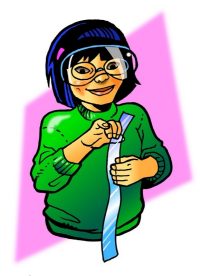
Procedure, part 1
Charged plastic and charged skin
- Cut 2 strips from a plastic grocery bag so that each is about 2–4 cm wide and about 20 cm long.
- Hold the plastic strip firmly at one end. Then grasp the plastic strip between the thumb and fingers of your other hand as shown.

- Quickly pull your top hand up so that the plastic strip runs through your fingers. Do this three or four times.
- Allow the strip to hang down. Then bring your other hand near it.
- Write “attract” or “repel” in the chart on the activity sheet to describe what happened.
Expected results
The plastic will be attracted to your hand and move toward it. Students may notice that the plastic is also attracted to their arms and sleeves. Let students know that later in this lesson they will investigate why the plastic strip is also attracted to surfaces that have not been charged (neutral).
Note: If students find that their plastic strip does not move toward their hand, it must not have been charged well enough. Have them try charging their plastic strip by holding it down on their pants or shirt and then quickly pulling it with the other hand. Then they should test to see if the plastic is attracted to their clothes. If not, students should try charging the plastic again.
4 Explain
Step 4
Show students models comparing the number of protons and electrons in the plastic and skin before and after rubbing them together.
Tell students that the plastic strip and their skin are made of molecules that are made of atoms. Tell students to assume that the plastic and their skin are neutral—that they have the same number of protons as electrons.
Project the image Charged plastic and hand.
Point out that before the students pulled the plastic between their fingers, the number of protons and electrons in each is the same. Then, when students pulled the plastic through their fingers, electrons from their skin got onto the plastic. Since the plastic has more electrons than protons, it has a negative charge. Since their fingers gave up some electrons, their skin now has more protons than electrons, so it has a positive charge. The positive skin and the negative plastic attract each other because positive and negative attract.
5 Explore
Step 5
Have students investigate what happens when a rubbed plastic strip is held near a desk or chair.
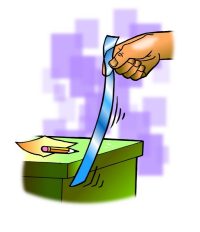
Procedure, part 2
Charged plastic and neutral desk
- Charge one strip of plastic the same way you did previously.
- This time, bring the plastic strip toward your desk or chair.
- Write “attract” or “repel” in the chart.
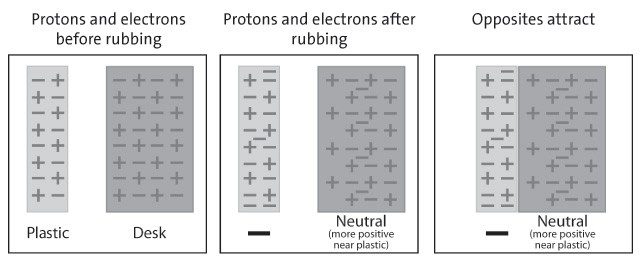
Step 6
Have students charge two pieces of plastic and hold them near each other to see if electrons repel one other.
Ask students to make a prediction:
- What do you think will happen if you charge two strips of plastic and bring them near each other?
Procedure, part 3
2 pieces of charged plastic
- Charge two strips of plastic
- Slowly bring the two strips of plastic near each other.
- Write “attract” or “repel” in the chart on the activity sheet.
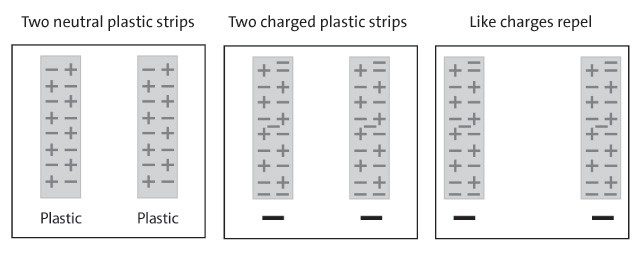
Expected results
The strips will move away or repel each other. Since both strips have extra electrons on them, they each have extra negative charge. Since the same charges repel one another, the strips move away from each other.
Ask students:
- What happened when you brought the two pieces of plastic near each other?
The ends of the strips moved away from each other. - Use what you know about electrons and charges to explain why this happens.
Each strip has extra electrons so they are both negatively charged. Because like charges repel, the pieces of plastic repelled each other.
6 Extend
Step 7
Have students apply their understanding of protons and electrons to explain what happens when a charged balloon is brought near pieces of paper.
Materials for each group
- Inflated balloon
- Small pieces of paper, confetti-size
Procedure
- Rub a balloon on your hair or clothes.
- Bring the balloon slowly toward small pieces of paper.
Ask students:
- What did you observe when the charged balloon was held near the pieces of paper?
The paper pieces moved up and stuck on the balloon. - Use what you know about electrons, protons, and charges to explain why this happens.
When you rub the balloon on your hair or clothes it picks up extra electrons, giving the balloon a negative charge. When you bring the balloon near the paper, the electrons from the balloon repel the electrons in the paper. Since more protons are at the surface of the paper, it has a positive change. The electrons are still on the paper, just not at the surface, so overall the paper is neutral. Opposites attract, so the paper moves up toward the balloon.
Show the simulation Balloons and Static Electricity from the University of Colorado at Boulder’s Physics Education Technology site.
In the simulation, check the boxes “show all charges” and “wall”. Uncheck everything else. In this simulation, you can rub the balloon a little bit on the sweater and see that some of the electrons from the sweater move onto the balloon. This gives the balloon a negative charge. Since the sweater lost some electrons, it has more protons than electrons, so it has a positive charge. If you move the balloon toward the sweater, it will be attracted. This is like moving the charged plastic strip toward the cloth it was rubbed on.
You can also move the balloon toward the wall. The excess negative charge on the balloon repels negative charge on the surface of the wall. This leaves more positive charge on the surface of the wall. The negatively charged balloon is attracted to the positive area on the wall. This is like moving the charged plastic strip toward the finger.
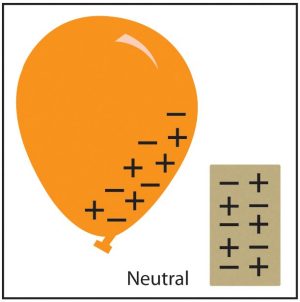
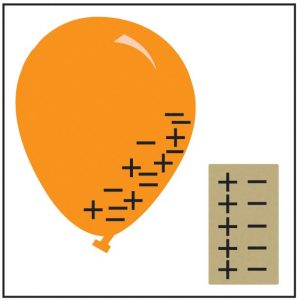
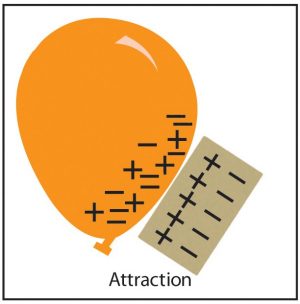
7 Extra Extend
Step 8
Demonstrate how electrons can attract a stream of water.
Either do the following demonstration or show the video Balloon and Water.
Materials for the demonstration
- Sink
- Balloon
Procedure
- Rub a balloon on your shirt or pants to give it a static charge.
- Turn on the faucet so that there is a very thin stream of water.
- Slowly bring the charged part of the balloon close to the stream of water.
Expected results
The stream of water should bend as it is attracted to the balloon.
Ask students:
- What did you observe when the charged balloon was held near the stream of water?
The stream of water bent toward the balloon. - Use what you know about electrons, protons, and charges to explain why this happens.
When you rub the balloon on your hair or clothes it picks up extra electrons, giving the balloon a negative charge. When you bring the balloon near the stream of water, the electrons from the balloon repel the electrons in the water. Since more protons are at the surface of the water, it has a positive change. Opposites attract, so the water moves toward the balloon.
What is the 5-E format?
The 5-E instructional model is an approach to teaching and learning that focuses on active engagement, inquiry-based learning, and collaboration.
Downloads
For Students
- Lesson 4.1 Student Activity Sheet PDF | DOCX | Google Doc
For Teachers
- Lesson 4.1 Lesson Plan PDF | DOCX | Google Doc
- Lesson 4.1 Activity Sheet Answers PDF | DOCX | Google Doc
Resources for the entire Chapter 4
- Chapter 4 Student Reading PDF | DOCX | Google Doc
- Chapter 4 Test Bank PDF | DOCX | Google Doc
Interactive Lesson Modules
- Lesson 4.1 Online Assignments Google Form
Have Questions? Visit Help Center
